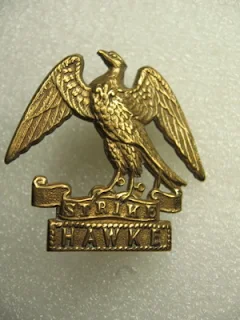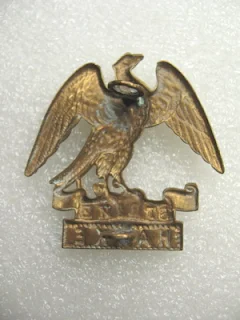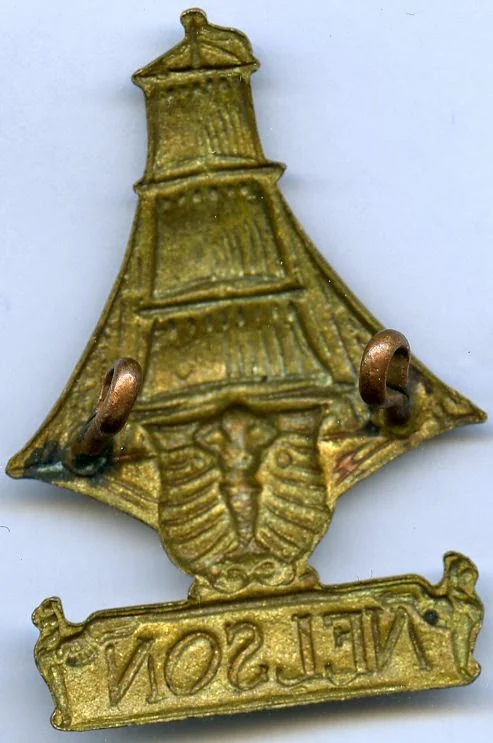This results in one valid set of cap badges being shown as if they were sealed pattern, at the unintended exclusion of legitimate variants from other manufacturers or a different set of genuine dies under contract (not re-strikes). Fortunately a second member of the forum has come forward with a complete set of the cap badges with reasonably established provenance. Both acknowledgement and gratitude are extended to 'Chrisr' of the forum for his contribution.
It was debated whether to publish this article as a new page, or incorporate it as an addendum to one of the previous other RND Badge discussions in the blog. Finally optioned for a new page, as the other could easily be lost in the intervening time warp. For cross-reference and the convenience of the reader the other pages are as follows; http://arnhemjim.blogspot.com/2011/08/wwi-royal-naval-division-cap-badges_28.html, and also; http://arnhemjim.blogspot.com/2011/08/wwi-royal-naval-division-cap-badges.html.
The badges are presented in the same alphabetic order as in the page entitled "WWI Royal Naval Division Cap Badges - A Forensic Analysis", the first badge being the Anson Battalion.
The second badge is the Drake Battalion. In this example it has a joined motto on the bottom and the font in the word DRAKE at the top is slightly finer than in the other genuine specimen.
The third badge is the Hawke Battalion. In this specimen neither of the talons touch the 'R' or 'I' in STRIKE. Both go over the raised bit of the scroll and the left talon (looking at the badge) touches the top of the 'T'. The bird is similar to the other cited genuine specimen but with a narrower head, however not the same as the copy. The fleur de lys however looks more like the copy. Also note the north/south orientation of the lugs.
Next is the Hood Battalion. Note that this example has a narrower font, no void between 'STEADY' and HOOD scrolls and the bird is slimmer, when compared to the genuine badge. Again note the north/south orientation of the lugs.
The badge of the Howe Battalion. As can be observed there is voiding between the pennants and the sails, however differing from the cited copy in that there are joins between the central ship's aft and the sails, and the joins between the other half hulls and the sails are thicker. Finally the metal is a yellower brass color.
Finally the badge of the Nelson Battalion. In the case of this specimen the pennant is the same as the other genuine example but not voided, and the ship's figurehead is not as broad. Also note the north/south orientation of the lugs.
Here are an additional pair of examples of the Nelson Battalion badge, both of which are modern copies intentionally made to decieve the buyer and profit for the seller. The first is artificially bronzed and aged, even incorporating a fraudulent J.R. Gaunt plaque to afford it added "authenticity". Also note the artificial wear induced on the right hand side of the sails and the figurehead. The second example may or may not be struck from the same fraudulent set of dies, but appears very similar while not including the Gaunt plaque.
On fact can be stipulated with absolute certainty. As experts will tell you, if ever offered a RND Benbow or Collingswood Cap Badge, courteously decline. WHATEVER badge it might be, it is sheer fantasy, as both battalions were disestablished prior to the issuance of any authorized badge.
As an adjunct of possible interest the following video is of the annual Royal Navy Field Gun Competition 1988, a competition that was held as part of the annual Royal Tournament (another tradition fallen casualty, however the competition endures) recreating/commemorating another historic land action by the Royal Navy. During the Boer War 1899-1902, Gun crews of HMS Terrible and HMS Powerful transported modified naval guns over land (190 mi., after a sea voyage of 800 naut. mi. from Simonstown to Durban.) to aid in the Relieve of Ladysmith, South Africa (28 February - 1 March 1900).
















No comments:
Post a Comment